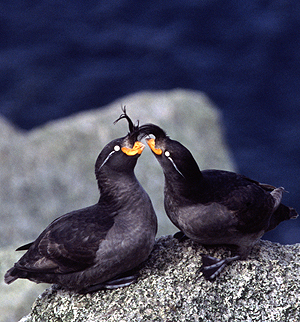Researchers tie crest size to seabirds' suitability as a mate
Researchers tie crest size to seabirds’ suitability as a mate
Submitted by Marmian Grimes
Phone: 907-474-7902
04/10/09

A newly released study by researchers at the University of Alaska Fairbanks offers evidence that in one breed of northern seabird, the size of males’ feather crests may be more than simple ornamentation.
Their study, published this month in of the Journal of Comparative Physiology B, shows that crest size may be a physical indicator of a male crested auklet’s quality as a mate.
Scientists have long noted that female auklets prefer males with larger crests. But until recently, they did not know why. Low levels of stress hormones in males with larger crests indicate that they cope better with the stresses of reproduction, such as finding food, competing with thousands of other birds for mates and nest sites, and helping rear chicks.
"Females will divorce shorter-crested mates for the opportunity to mate with longer-crested males. Our study suggests that longer-crested males could contribute more to reproductive success because they have greater capacity to meet the social and physiological costs," said Hector Douglas, assistant professor of biology at the Kuskokwim Campus in Bethel.
Douglas and collaborator Alexander Kitaysky, an associate professor at the UAF Institute of Arctic Biology, say their results fit into a larger theory about animal societies.
"There appears to be a social hierarchy at the colony which is correlated with the size of the male ornament and this, in turn, is related to the levels of stress hormones," Douglas said. "The cost of attaining and maintaining dominant status is reflected in the animals’ physiology and this has a distinct pattern in the society."
Douglas and his field team studied the small, sooty-gray seabirds during fieldwork on Big Koniuji in the Shumagin Islands in the Aleutian Chain during June and July of 2002. They captured and measured the auklets at a mountainside colony and collected blood samples. Kitaysky’s lab analyzed the blood samples for the stress hormone corticosterone. They found that larger crests correlated with lower levels of corticosterone in the males’ bloodstream.
"Theoretically males that have a lower level of baseline stress hormone have a greater capacity to respond to additional stress," Douglas said. "The males with the larger crests had markedly lower levels of corticosterone and therefore they should be better mates. We suspect that crest size is an outward indicator of intrinsic quality, and the data on hormones appears to confirm this."
The project was funded by the Eppley Foundation for Research Inc. and the Angus Gavin Memorial Bird Research Fund, through the University of Alaska Foundation. The Alaska Sea Grant College Program and the Center for Global Change and Arctic System Research provided additional logistical support.
CONTACT: Hector Douglas, assistant professor of biology, at 907-543-4589 or via e-mail at hddouglas@yahoo.com. Marmian Grimes, UAF public information officer, at 907-474-7902 or via e-mail at marmian.grimes@uaf.edu.
MG/4-10-09/148-09


